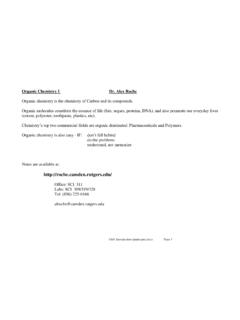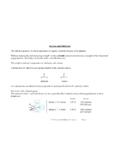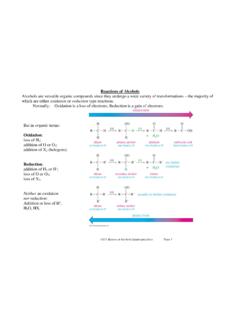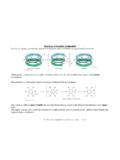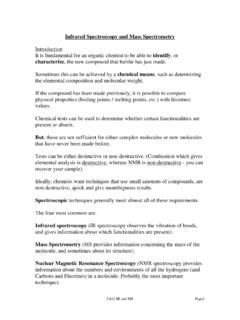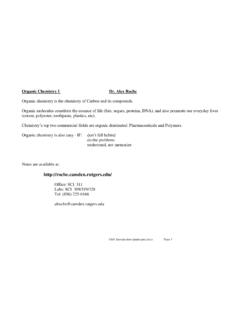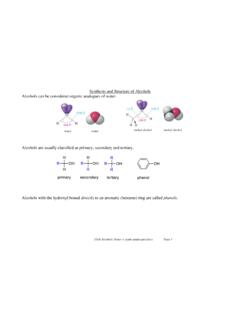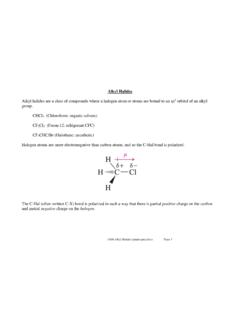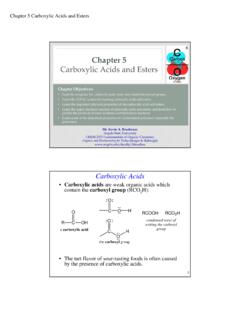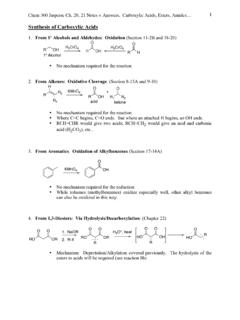Transcription of Carboxylic Acids - Rutgers University
1 Ch20 Carboxylic Acids (landscape).docx Page 1 Carboxylic Acids When a carbonyl carbon also bears a hydroxyl group, then these compounds are appreciably acidic, and are called Carboxylic Acids . Carboxylic Acids are classified according to the substituent that is bonded to the carboxyl carbon: Aliphatic Acids have an alkyl group bound to the carboxyl group. An aromatic acid has an aryl group bound to the carboxyl group. The simplest acid is formic acid . A Carboxylic acid donates protons by the heterolytic cleavage of the O-H bond, generating a carboxylate ion. RCOO-HRCOOHRCO2H Ch20 Carboxylic Acids (landscape).docx Page 2 Nomenclature IUPAC formulation The root name is based on the longest continuous chain of carbon atoms bearing the carboxyl group.
2 The -e is replaced by -oic acid . The chain is numbered starting with the carboxyl carbon atom. The carboxyl group takes priority over any other functional groups previously discussed. Ch20 Carboxylic Acids (landscape).docx Page 3 Unsaturated Acids are named using the name of the alkene with -e replaced with -oic acid . The chain is numbered starting with the carboxyl group, and a number designates the location of the multiple bond (and may include Z or E). Cycloalkanes with carboxyl substituents are named as cycloalkanecarboxylic Acids . (Notice that -CO2H as a substituent makes the carbon it is bound to C-1, not itself). Ch20 Carboxylic Acids (landscape).docx Page 4 Typically aromatic Acids of the form Ar-CO2H are named as derivatives of benzoic Acids , with ortho, meta and para indicating the location relative to the carboxyl group.
3 (Recall that this is non-IUPAC). Ch20 Carboxylic Acids (landscape).docx Page 5 Dicarboxylic Acids Aliphatic dicarboxylic Acids are named by simply adding the suffix -dioic acid to the root name. The root name comes from the longest carbon chain containing both carboxyl groups. Numbering starts at the end closest to a substituent. Structure of the Carboxyl Group The most stable conformation of formic acid is an almost planar arrangement of the molecule. The carbon is sp2 hybridized, and the O-H bond lies in the plane described by the sp2 carbon, eclipsing the C=O double bond. This unexpected geometric arrangement can be explained by resonance (or conjugation). Ch20 Carboxylic Acids (landscape).docx Page 6 Three resonance forms can be written for formic acid .
4 The second structure requires the C-O-H bonds to be co-planar. One of the unshared lone pairs of oxygen is delocalized into the electrophilic system of the carbonyl group. (One of the lone pairs on the hydroxyl oxygen is conjugated with the C=O double bond). Acidity Carboxylic Acids can dissociate in aqueous solution into carboxylate ions and protons. The equilibrium constant for this process is Ka, and more frequently we talk in terms of pKa. Ch20 Carboxylic Acids (landscape).docx Page 7 Values of pKa for common alkyl Carboxylic Acids are around 5 (Ka ~ 10-5). Ch20 Carboxylic Acids (landscape).docx Page 8 ethanoic acid has pKa = , (alcohols have pKa ~ 16, so Carboxylic Acids are about 1011 times more acidic than alcohols).
5 The reason why Carboxylic Acids are much more acidic than alcohols is because the carboxylate anion is much more stable than the alkoxide anion. Both alcohols and Carboxylic Acids are acidic since their respective O-H bonds can be broken heterolytically, giving a proton and an oxygen anion. The difference lies in the fact that the carboxylate anion has the negative charge spread out over two oxygen atoms, whereas the alkoxide has the negative charge localized on a single oxygen atom. Ch20 Carboxylic Acids (landscape).docx Page 9 The carboxylate anion can be viewed as a resonance hybrid of the two anionic structures, or as a conjugated system of three interacting p orbitals containing four electrons (like the allylic anion system). The C and two oxygens are all sp2 hybridized, and the remaining p orbitals create the MO system giving rise to the half bond between each C and O, and the half negative charge on the end oxygens.
6 Dicarboxylic Acids These have two dissociation constants, since they can lose two protons. Ka1 for the first dissociation, and Ka2 for the second dissociation (which generates a dianion). Ka2 is always less than Ka1 (the second carboxyl group is less acidic) since it takes extra energy to overcome the second negative charge being so close to the first negative charge. Ch20 Carboxylic Acids (landscape).docx Page 10 Substituent Effects on Acidity Any substituent that stabilizes a negative charge is going to enhance the dissociation process, and therefore result in a stronger acid . Thus electronegative elements can enhance the acid strength, through inductive effects. The closer the substituent to the anion, the more profound the effect.
7 Ch20 Carboxylic Acids (landscape).docx Page 11 Salts of Carboxylic Acids Strong bases can completely deprotonate Carboxylic Acids , thus salts of Carboxylic Acids are formed. The acid can be regenerated by protonation (acidification) of the salt. Ch20 Carboxylic Acids (landscape).docx Page 12 Syntheses of Carboxylic Acids The previously seen syntheses (three) all involved oxidation: (a) oxidation of primary alcohols and aldehydes. (b) oxidative cleavage of alkenes and alkynes. (c) side chain oxidation of alkyl benzenes. Oxidation of Primary Alcohols and Aldehydes These oxidations are best performed using chromic acid (made from Na2Cr2O7 and H2SO4). Potassium permanganate can be used but gives lower yields. Ch20 Carboxylic Acids (landscape).
8 Docx Page 13 Cleavage of Alkynes and Alkenes Alkenes react with concentrated KmnO4 to produce intermediate glycols which react further to produce either Carboxylic Acids or ketones (depending on the original alkene substituents). Alkynes also react with conc. KMnO4 to give Carboxylic Acids , and the same transformation can be achieved by the use of ozonolysis. Ch20 Carboxylic Acids (landscape).docx Page 14 Alkylbenzenes Benzoic acid derivatives can be made by the oxidation of alkylbenzenes with either hot KMnO4 or hot chromic acid . The vigorous conditions means this can only be used when there are no oxidizable groups present in the molecule. Ch20 Carboxylic Acids (landscape).docx Page 15 New methods Carboxylation of Grignard Reagents Grignard reagents can react as nucleophiles and attack carbon dioxide.
9 This results in magnesium salts of Carboxylic Acids , and treatment with dilute acid produces a Carboxylic acid . The overall transformation is from alkyl halide to a Carboxylic acid with an extra carbon atom. Ch20 Carboxylic Acids (landscape).docx Page 16 Formation and Hydrolysis of Nitriles Nitriles can be hydrolyzed by dilute acid to generate Carboxylic Acids . Nitriles are easily made by the action of cyanide ion as a nucleophile on alkyl halides (or tosylates). Again the overall transformation is from alkyl halide to a Carboxylic acid with an extra carbon atom. Ch20 Carboxylic Acids (landscape).docx Page 17 Reactions of Carboxylic Acids (and Derivatives) Ketones and aldehydes have a carbonyl group and undergo nucleophilic addition, whereas Carboxylic Acids (and their derivatives) undergo nucleophilic acyl substitution - this is where one nucleophile replaces a leaving group on the acyl carbon.
10 Carboxylic acid derivatives differ in the nature of the group bound to the acyl group. -OH is an acid -Cl is the acid chloride -OCOR' is the anhydride -OR' is the ester -NR2 is the amide Nucleophilic acyl substitution can interconvert all of these different acid derivatives. Ch20 Carboxylic Acids (landscape).docx Page 18 The mechanism for nucleophilic acyl substitution varies depending if it occurs under acidic or basic conditions (similar to acid and base varieties of nucleophilic addition to aldehydes/ketones). Under basic conditions, a strong nucleophile can attack the carbonyl carbon, thus generating a tetrahedral intermediate. This intermediate can then expel its leaving group. the above ester hydrolysis to a Carboxylic acid .
